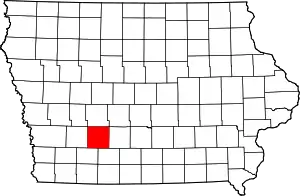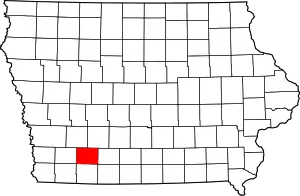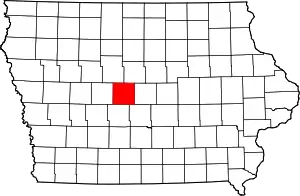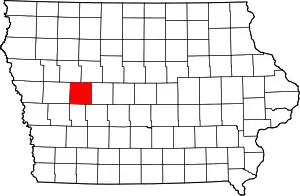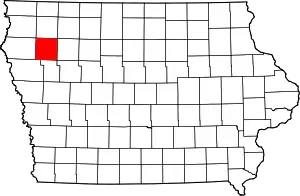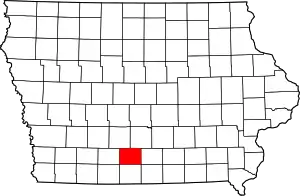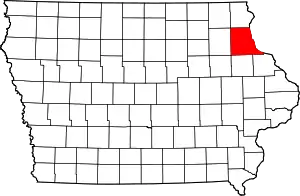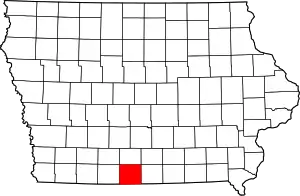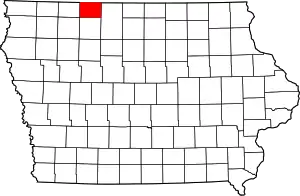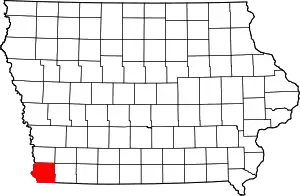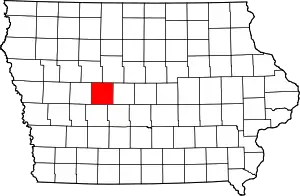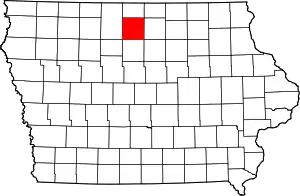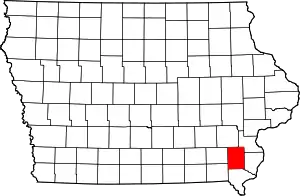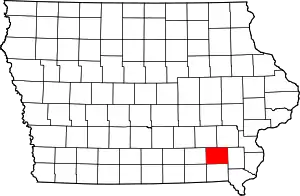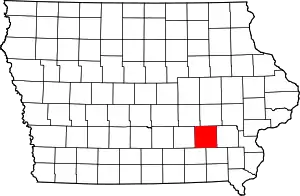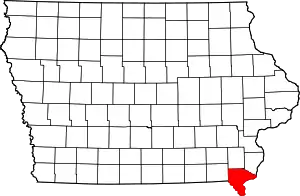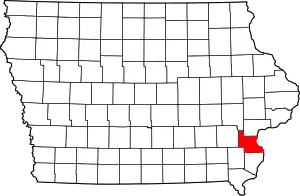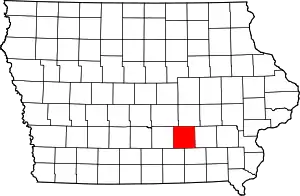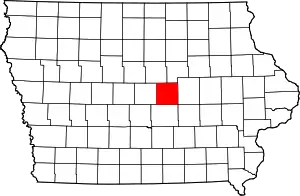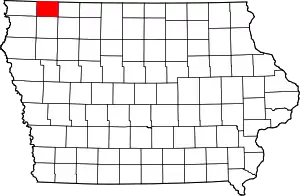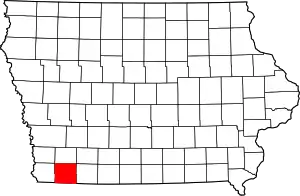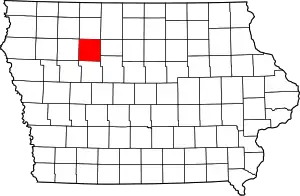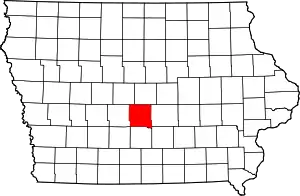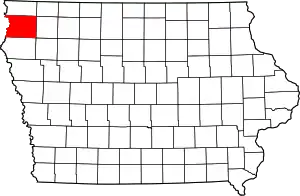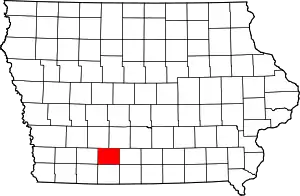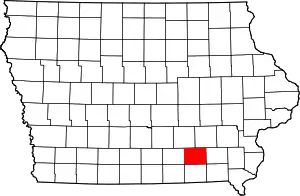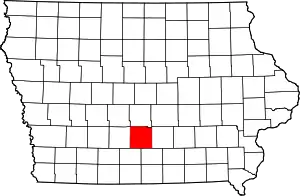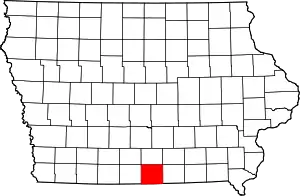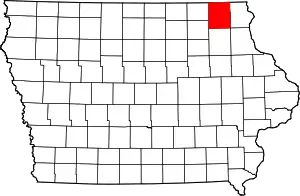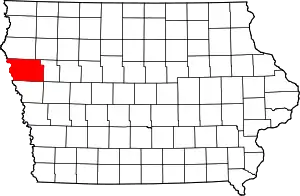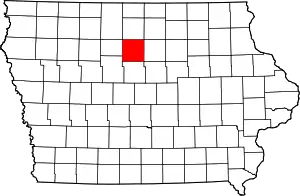| Counties of Iowa | |
|---|---|
| Location | State of Iowa |
| Number | 99 |
| Populations | 3,611 (Adams) – 501,089 (Polk) |
| Areas | 381 square miles (990 km2) (Dickinson) – 973 square miles (2,520 km2) (Kossuth) |
| Government | |
| Subdivisions |
|
There are 99 counties in the U.S. state of Iowa. The first two counties, Des Moines County and Dubuque County, were created in 1834 when Iowa was still part of the Michigan Territory. In preparation for Michigan's statehood, part of Michigan Territory was formed into Wisconsin Territory in 1836.[1] Two years later, the western portion was split off to become Iowa Territory.[2] The south-eastern part of Iowa Territory became Iowa, the 29th state in the union, on 28 December 1846,[3] by which point 44 counties had been created. Counties continued to be created by the state government until 1857, when the last county, Humboldt County, was created.[4] One of the most significant days in Iowa county history was January 15, 1851, on which 49 counties were created.[5]

The Iowa Constitution of 1857, which is still in effect today, states that counties must have an area of at least 432 square miles (1,120 km2), and no county may be reduced below that size by boundary changes.[6] However, exceptions to this rule were granted, as ten counties have areas below this size. (The table below shows land area, but the Constitution deals with total area.[6]) The smallest county (Dickinson) has a land area of 381 sq mi (990 km2), while the largest (Kossuth) has an area 973 sq mi (2,520 km2). Polk County is the most densely populated county at 864/sq mi (333.5/km2), an increase in density from 2010 when it was 655.5/sq mi (253.08/km2).[7] Polk County contains the state's capital and largest city, Des Moines. In addition, Iowa has one of the smallest percentages of counties whose boundaries are dictated by natural means, the vast majority of which are being formed by lines of survey instead, resulting in many "box counties".
County information
The Federal Information Processing Standard (FIPS) code, used by the United States government to uniquely identify counties, is provided with each entry. The FIPS code for each county links to census data for that county. The column labeled '#' is the official county number when listed alphabetically. This number is used for many governmental and organizational purposes, including state income tax preparation.[8] From 1922 to 1978, it was also used on Iowa license plates[9] until it was replaced by the full county name. Finally, the number in the column headed "Map #" is used by the National Atlas of the United States, shown on the left; for purposes of the National Atlas, counties are numbered in geographical order beginning in the NW corner of the map.
Former counties
The following counties no longer exist:[21]
- Bancroft (1851–1855), merged with Kossuth County[22]
- Cook (1836–1837), merged with Muscatine County[23]
- Crocker (1870–1871), merged with Kossuth County[24]
- Risley (1851–1853), formed Hamilton County[25]
- Yell (1851–1853), formed Webster County[26]
See also
References
- ↑ "The Creation of Wisconsin Territory". Wisconsin Historical Society. Retrieved 2008-08-17.
- ↑ "Chronology of Wisconsin History". Ney Family History. Archived from the original on 2008-05-19. Retrieved 2008-08-17.
- ↑ "Statehood Dates". 50states.com. Retrieved 2008-08-17.
- 1 2 3 4 National Association of Counties. "NACo - Find a county". Archived from the original on 2005-04-10. Retrieved 2008-04-30.
- ↑ "Iowa: Consolidated Chronology of State and County Boundaries". Archived from the original on 2009-04-16. Retrieved 2008-05-25.
- 1 2 "Iowa Commentary". Iowa Atlas of Historical County Boundaries. Archived from the original on 2008-10-15. Retrieved 2008-08-16.
- ↑ U.S. Census Bureau. "Polk County Quickfacts". State & County QuickFacts. Archived from the original on 2011-07-29. Retrieved 2021-09-03.
- ↑ "Iowa County Names and Numbers" (PDF). Iowa Department of Revenue. Archived from the original (PDF) on 2017-03-23. Retrieved 2018-06-08.
- ↑ "Iowa License Plate: County Codes". Archived from the original on 2018-12-19. Retrieved 2018-06-08.
- ↑ "EPA County FIPS Code Listing". EPA.gov. Retrieved 2008-02-23.
- 1 2 Pratt, LeRoy G. (1977). The Counties and Courthouses of Iowa. Mason City, Iowa: Klipto Printing and Office Supply Company.
- ↑ "Formation of Counties in Iowa". Retrieved 2015-12-24.
- ↑ "U.S. Census Bureau QuickFacts: Iowa". United States Census Bureau. Retrieved 2023-04-07.
- 1 2 Bright, William (2004). Native American Placenames of the United States. Norman, Oklahoma: University of Oklahoma Press. ISBN 978-0-8061-3598-4.
- ↑ "Henry County, Iowa". Retrieved 2008-08-17.
According to most sources, Henry County (440 square miles) was named for Henry Dodge (1782-1867), who served in the Black Hawk War and other Indian wars and governor of Wisconsin Territory (1836-1841); others credit the county's name to General James Dougherty Henry (1797-1834), a hero of the Black Hawk War.
- ↑ Savage, Tom (2007). A Dictionary of Iowa Place-names. Iowa City: University of Iowa Press. p. 9. ISBN 1-58729-531-8.
- ↑ Doubek, James (June 27, 2021). "Johnson County, Iowa, Renames Itself After A Different Johnson". National Public Radio. Retrieved June 28, 2021.
- ↑ "Louisa County, Iowa". Official website. Retrieved 2008-08-17.
According to some authorities, the county was named for Louisa Massey, who gained fame during her time because she avenged the murder of her brother by shooting the man responsible. Other historians claim the name was given in honor of Louisa County, Virginia. There are 418 square miles (1,080 km2) in Louisa County.
- ↑ John Adams, Tama County Auditor (2002). "Tama County, Iowa". e-referencedesk.com. Clarksville, VA: Web Marketing Services, Inc. LLC. Archived from the original on 2011-06-06. Retrieved 2008-10-02.
The origin of the naming of Tama County is somewhat disputed. Some authorities say the name comes from Taimah, a Fox Indian Chief. Others say it comes from Taomah, wife of Poweshiek--another Fox Indian Tribe Chief. Still others say the county is named after the Indian Chief Potama or Pottama.
- ↑ Pratt, H. M. (1913). History of Fort Dodge and Webster County, Iowa.
- ↑ "Iowa County Formation Table". Iowa Genweb Project. Retrieved 2015-12-24.
- ↑ "Bancroft County, Iowa". Archived from the original on 2011-07-27. Retrieved 2008-08-16.
- ↑ "Cook County, Iowa". Archived from the original on 2004-07-14. Retrieved 2008-08-16.
- ↑ "Crocker County, Iowa". Archived from the original on 2004-07-15. Retrieved 2008-08-16.
- ↑ "Risley County, Iowa". Archived from the original on 2016-02-20. Retrieved 2008-08-16.
- ↑ "Yell County, Iowa". Archived from the original on 2004-07-20. Retrieved 2008-08-16.

